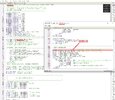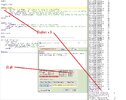DogFlu66
Member
Hello; on this occasion I leave a simple linear buffer.
Specially applied for the RS232 port.
To avoid losing data, what is done is to add another software buffer to the hardware buffer of the pic (2 bytes). The length of the latter will depend on the user's needs and the amount of memory available. This is for those who are interested in learning how a simple buffer works and how it is complemented by the asynchronous pic module, in this case the usat module.
The input data blocking check has been implemented, since apparently those who start working with this type of port are not clear that if the pic buffer is overloaded it is blocked and stops working, and to activate it again you have to reset the control bits of the internal buffer of the pic.
If anyone sees that improvements can be made or another better algorithm can be presented, they can share it.
I leave the main program and the functions necessary for it to work as attachments.
Main program:
'Example of buffer for RS232 port
'Pic12F1840, 08/12/2023
Define CONFIG1 = 0x0f84
Define CONFIG2 = 0x1dff
Include "_FuncionesPic12F1840.bas"
Include "_Funciones_Buffer_RS232.Bas"
Define CLOCK_FREQUENCY = 32 '32Mhz system oscillator
'constants (ASCII control codes).
Const FF = 0x0c 'FF, page advance
Const Bell = 0x07 'Bell, sound signal
Const Sp = 0x20 'Sp, space
Const Bksp = 0x08 'Bksp, go back
'Const Cr = 0x0d 'Cr, car return
'Const Lf = 0x0a 'Lf, line break
Const Ctrlz = 0x1a 'Ctrl - Z
Const Esc = 0x1b 'Escape
main:
'Call _setup_oscillator_mode(_oscillator_by_fosc) 'Select by configuration word.
Call _setup_oscillator(_osc_32mhz_hf) 'Interno 8Mhz x 4(PLL) = 32Mhz
AllDigital
TRISA = 0xff
UART_Init 9600 'Initialize port pin (default: A0 = Tx, RA1 = Rx)
Call _uart_pin_tx_ra4(True) 'Pin Tx = RA4
Call _uart_pin_rx_ra5(True) 'Pin Rx = RA5
WaitMs 10
Call _setup_buffer_rs232() 'Initialize buffer by software
Call _enable_interrupts(_int_rda) 'Enables uart interrupts
Call _enable_interrupts(_global) 'Enables peripheral and global interrupts.
Dim data As Byte
UART_Write "Ready", CrLf
While True
If _buffer() = True Then 'If there is data in the buffer.
'data = _read_buffer_rs232()'Reads byte fron buffer and assigns it to a variable.
'UART1_Write data'Write the byte to the serial port.
UART_Write _read_buffer_rs232() 'Reads byte fron buffer and write to the serial port.
Endif
Wend
End
On Interrupt
Save System
If _uartif = True Then 'If there is data in the uart hardware buffer.
Call _get_rs232() 'Moves a byte from the hardware buffer to the software buffer.
Endif
Resume
Specially applied for the RS232 port.
To avoid losing data, what is done is to add another software buffer to the hardware buffer of the pic (2 bytes). The length of the latter will depend on the user's needs and the amount of memory available. This is for those who are interested in learning how a simple buffer works and how it is complemented by the asynchronous pic module, in this case the usat module.
The input data blocking check has been implemented, since apparently those who start working with this type of port are not clear that if the pic buffer is overloaded it is blocked and stops working, and to activate it again you have to reset the control bits of the internal buffer of the pic.
If anyone sees that improvements can be made or another better algorithm can be presented, they can share it.
I leave the main program and the functions necessary for it to work as attachments.
Main program:
'Example of buffer for RS232 port
'Pic12F1840, 08/12/2023
Define CONFIG1 = 0x0f84
Define CONFIG2 = 0x1dff
Include "_FuncionesPic12F1840.bas"
Include "_Funciones_Buffer_RS232.Bas"
Define CLOCK_FREQUENCY = 32 '32Mhz system oscillator
'constants (ASCII control codes).
Const FF = 0x0c 'FF, page advance
Const Bell = 0x07 'Bell, sound signal
Const Sp = 0x20 'Sp, space
Const Bksp = 0x08 'Bksp, go back
'Const Cr = 0x0d 'Cr, car return
'Const Lf = 0x0a 'Lf, line break
Const Ctrlz = 0x1a 'Ctrl - Z
Const Esc = 0x1b 'Escape
main:
'Call _setup_oscillator_mode(_oscillator_by_fosc) 'Select by configuration word.
Call _setup_oscillator(_osc_32mhz_hf) 'Interno 8Mhz x 4(PLL) = 32Mhz
AllDigital
TRISA = 0xff
UART_Init 9600 'Initialize port pin (default: A0 = Tx, RA1 = Rx)
Call _uart_pin_tx_ra4(True) 'Pin Tx = RA4
Call _uart_pin_rx_ra5(True) 'Pin Rx = RA5
WaitMs 10
Call _setup_buffer_rs232() 'Initialize buffer by software
Call _enable_interrupts(_int_rda) 'Enables uart interrupts
Call _enable_interrupts(_global) 'Enables peripheral and global interrupts.
Dim data As Byte
UART_Write "Ready", CrLf
While True
If _buffer() = True Then 'If there is data in the buffer.
'data = _read_buffer_rs232()'Reads byte fron buffer and assigns it to a variable.
'UART1_Write data'Write the byte to the serial port.
UART_Write _read_buffer_rs232() 'Reads byte fron buffer and write to the serial port.
Endif
Wend
End
On Interrupt
Save System
If _uartif = True Then 'If there is data in the uart hardware buffer.
Call _get_rs232() 'Moves a byte from the hardware buffer to the software buffer.
Endif
Resume
Attachments
Last edited:




